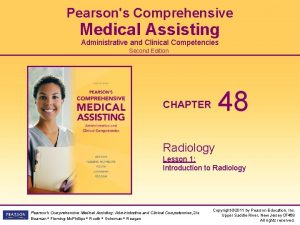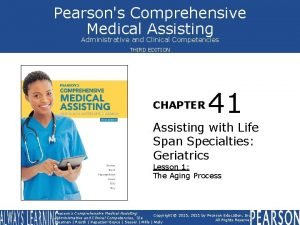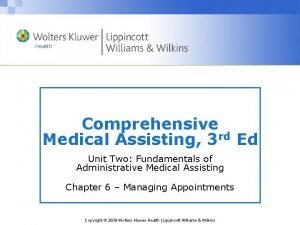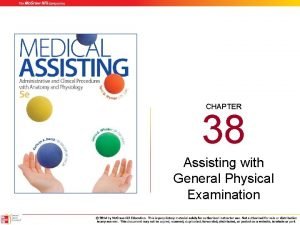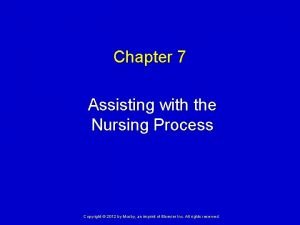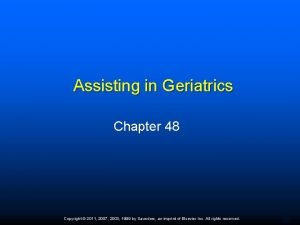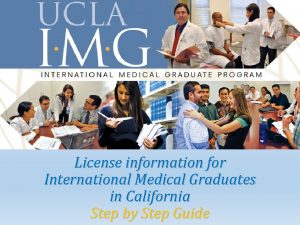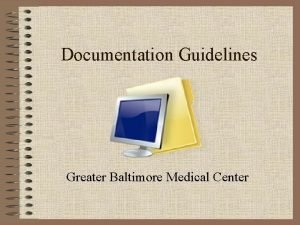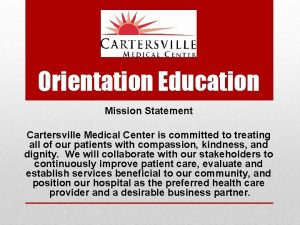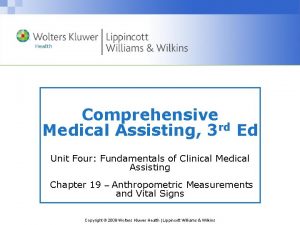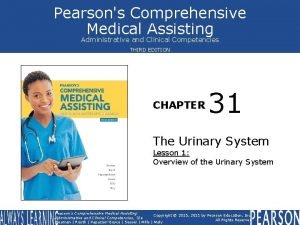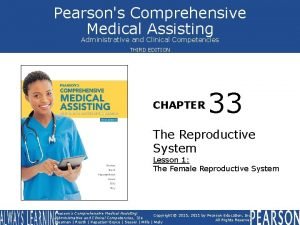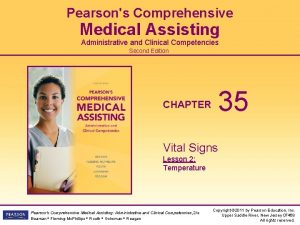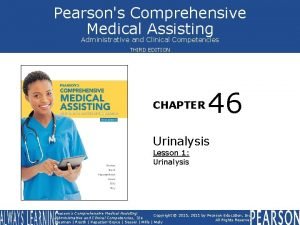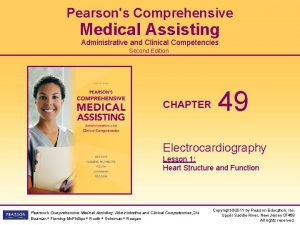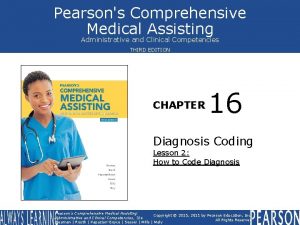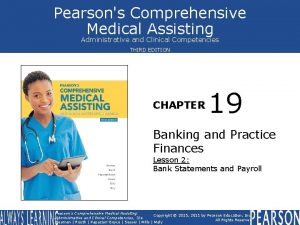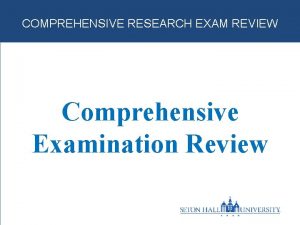Comprehensive Medical Assisting 3 rd Ed Unit Two


























- Slides: 26

Comprehensive Medical Assisting, 3 rd Ed Unit Two: Fundamentals of Administrative Medical Assisting Chapter 6 – Managing Appointments Copyright © 2009 Wolters Kluwer Health | Lippincott Williams & Wilkins

Appointment Scheduling Systems Manual Appointment Scheduling • The appointment book should have space for – Each provider’s appointments – Appointment info, including patients’ name, phone numbers, and reasons for visits • Establish the matrix; cross out unavailable times – Meetings, vacations, rounds, “buffers” • Review carefully and communicate with staff • Document all cancellations and reschedules Copyright © 2009 Wolters Kluwer Health | Lippincott Williams & Wilkins

Sample Page From a Manual Appointment Book Copyright © 2009 Wolters Kluwer Health | Lippincott Williams & Wilkins

Appointment Scheduling Systems Computerized Appointment Scheduling • Main advantage: Convenience – One-time entry of repeating schedule components – Easy search for available appointment times – Many useful printout formats – Interface with account information Copyright © 2009 Wolters Kluwer Health | Lippincott Williams & Wilkins

Types of Scheduling Structured Appointments – Each patient is allotted a fixed time and duration • Advantages – Optimum use of time and facility – Opportunity for advance preparation • Disadvantage – Patients may need more time than expected – Pin down time needs – Incorporate “buffer” time Copyright © 2009 Wolters Kluwer Health | Lippincott Williams & Wilkins

Types of Scheduling Structured Appointments – Methods • Clustering patients with similar needs • Wave or modified wave – Multiple patients scheduled in blocks • Fixed – Each patient assigned a specific time and duration • Streaming – Time is allotted according to anticipated need • Double booking – Two patients for each time slot Copyright © 2009 Wolters Kluwer Health | Lippincott Williams & Wilkins

Types of Scheduling Flexible Hours – Different times on different days • Accommodate patients and providers with varied schedules Open hours – First come, first serve • Eliminates some patient complaints • Effective time management is difficult • Can raise confidentiality issues Copyright © 2009 Wolters Kluwer Health | Lippincott Williams & Wilkins

Factors that Affect Scheduling Patients’ Needs • Reason for appointment • Staff to be seen • Duration of symptoms • Third-party payer constraints • Acute or chronic condition • Most convenient time • Documentation requirements • Transportation constraints You control the schedule; don’t let it control you! Copyright © 2009 Wolters Kluwer Health | Lippincott Williams & Wilkins

Factors that Affect Scheduling Providers’ Preferences and Needs • Adjust to each provider’s punctuality habits • Allow each provider time for other duties – Receive and return calls – Review reports – Dictate notes – Outside duties • Establish protocols for unscheduled visitors Copyright © 2009 Wolters Kluwer Health | Lippincott Williams & Wilkins

Factors that Affect Scheduling Physical Facilities • Number of users • Amount of space • Quantity and availability of equipment Understand the space and equipment required. Copyright © 2009 Wolters Kluwer Health | Lippincott Williams & Wilkins

Scheduling Guidelines General Guidelines • Always write the patient’s phone number on the schedule • Leave open time slots every day to accommodate problems Be pleasant and helpful Copyright © 2009 Wolters Kluwer Health | Lippincott Williams & Wilkins

Scheduling Guidelines New Patients • Get patient contact, referrer, and payer information • Explain payment policy and paperwork needs • Give directions, establish a message protocol, and confirm the date and time • Check your own work • Contact the referring physician The first encounter is critical. Copyright © 2009 Wolters Kluwer Health | Lippincott Williams & Wilkins

Scheduling Guidelines New Patients • Check the schedule for possible conflicts • Offer a specific date and time • Put the patient’s name and phone number on the schedule • Provide the patient with an appointment card • Check your work Copyright © 2009 Wolters Kluwer Health | Lippincott Williams & Wilkins

Patient Reminders Appointment Cards • Include the patient’s name, date and time of appointment, and physician’s name and phone number • Try to keep series on the same day and time • Provide a card for the next appointment only • Write in ink Copyright © 2009 Wolters Kluwer Health | Lippincott Williams & Wilkins

An Appointment Card Will Help the Patient Remember His or Her Appointment and Reduce No Shows Copyright © 2009 Wolters Kluwer Health | Lippincott Williams & Wilkins

Patient Reminders Telephone Reminders – Call the day before using the phone number agreed – Keep it simple, including your name, your office, and the appointment date and time – Check the move-up list and document the call Mailed Reminder Cards – Send at least a week before – Maintain stock postcards and a tickler file for annual examination reminders Copyright © 2009 Wolters Kluwer Health | Lippincott Williams & Wilkins

Sample Reminder Postcard Copyright © 2009 Wolters Kluwer Health | Lippincott Williams & Wilkins

Adapting the Schedule Emergencies • Have policies to determine can the emergency be treated in the office? • Have questionnaires to evaluate for a constellation of symptoms Patients Who Are Acutely Ill • Obtain the information the physician needs to decide when the patient should be seen Copyright © 2009 Wolters Kluwer Health | Lippincott Williams & Wilkins

Adapting the Schedule Walk-In Patients • See emergencies ASAP; refer decisions to physician – Work in or reschedule Late Patients • The patient must wait until the physician is free • Establish an office rescheduling policy • Schedule habitually late patients at the end of the day Copyright © 2009 Wolters Kluwer Health | Lippincott Williams & Wilkins

Adapting the Schedule Physician Delays • Call patients as soon as possible to reschedule • Inform patients in the waiting room at once Missed Appointments • Determine the reason and reschedule • Notify the physician of habitual no-shows Document, document! Copyright © 2009 Wolters Kluwer Health | Lippincott Williams & Wilkins

Cancellations By the Office • Notify patients ASAP; ask the patients to call to reschedule • Apologize to patients in the office By the Patient • Determine the reason • Make sure patient understands the need for follow-up • Check the move-up list to fill the vacancy • Notify the physician of habitual no-shows Document, document! Copyright © 2009 Wolters Kluwer Health | Lippincott Williams & Wilkins

Making Appointments for Patients in Other Facilities Referrals and Consultations • Check insurance requirements, including precertification and paperwork. Is the physician on the preferred list? • Provide physician and patient contact info, including the reason and urgency and whether it is a consultation or referral • Record the call • Ask for notice of no-show • Provide written notice to the patient • If patient makes an appointment, ask for notice Copyright © 2009 Wolters Kluwer Health | Lippincott Williams & Wilkins

Making Appointments for Patients in Other Facilities Diagnostic Testing • Get instructions – What test(s), how soon • Get patient conflicts • Provide the laboratory with patient info, patient lab and appointment info • Provide the patient with verbal and written explanation of any required preparation • Document the appointment and post the target date for results in your tickler file Copyright © 2009 Wolters Kluwer Health | Lippincott Williams & Wilkins

Making Appointments for Patients in Other Facilities Surgery • Determine and follow precertification requirements • Call the facility with the physician’s requirements – Patient info and insurance info and precertification number • Provide the patient with any preadmission forms or instructions • Write down dates, times, and locations for the patient • Document the appointment • If necessary, arrange for hospital admission Copyright © 2009 Wolters Kluwer Health | Lippincott Williams & Wilkins

When the Appointment Schedule Does Not Work If problems are frequent • Evaluate 2 to 3 months of the schedule • Involve all staff in your study • Identify persistent problems – Habitual lateness – Insufficient time allotted – Too many staff make appointments • Adjust routines to address the problem Copyright © 2009 Wolters Kluwer Health | Lippincott Williams & Wilkins

End of Presentation Copyright © 2009 Wolters Kluwer Health | Lippincott Williams & Wilkins
 Pearson's comprehensive medical assisting
Pearson's comprehensive medical assisting Chapter 41 assisting in geriatrics
Chapter 41 assisting in geriatrics Medical assistant rop
Medical assistant rop Chapter 42 assisting in other medical specialties
Chapter 42 assisting in other medical specialties Chapter 31 assisting in a medical emergency
Chapter 31 assisting in a medical emergency Chapter 42 assisting in other medical specialties
Chapter 42 assisting in other medical specialties Welcoming and greeting the guest procedure
Welcoming and greeting the guest procedure Assisting with a general physical examination
Assisting with a general physical examination Chapter 6 dental assisting
Chapter 6 dental assisting Noun form of advertise
Noun form of advertise Chapter 5 assisting with the nursing process
Chapter 5 assisting with the nursing process Assisting in microbiology and immunology
Assisting in microbiology and immunology Chapter 41 assisting in geriatrics
Chapter 41 assisting in geriatrics Juliette southard
Juliette southard Unit 6 review questions
Unit 6 review questions Ptal california medical board
Ptal california medical board Gbmc medical records
Gbmc medical records Difference between medical report and medical certificate
Difference between medical report and medical certificate Torrance memorial transitional care unit
Torrance memorial transitional care unit Cartersville medical center medical records
Cartersville medical center medical records Parts of comprehensive report
Parts of comprehensive report Villanova comprehensive science major
Villanova comprehensive science major Comprehensive care plan
Comprehensive care plan Washington comprehensive assessment of science
Washington comprehensive assessment of science Staxi2
Staxi2 Comprehensive research definition
Comprehensive research definition Operating income meaning
Operating income meaning
